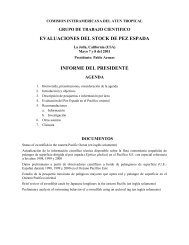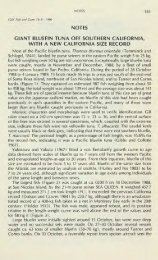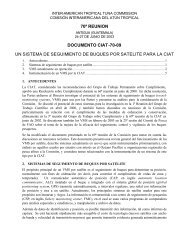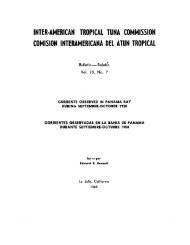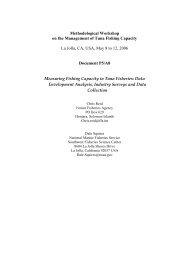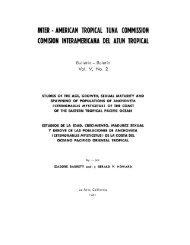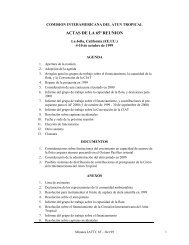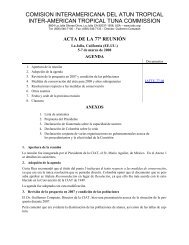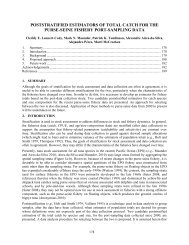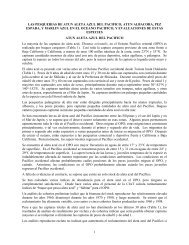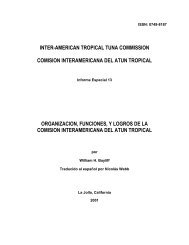76Es importante señalar que la curva que relaciona al rendimiento máximo promedio a la mortalidada por pesca a largo plazo es muyplana alrededor del nivel de RMS (Figura B-9). Por lo tanto, cambios en los niveles de esfuerzo a largo plazo cambiarán las capturasa largo plazo de forma marginal solamente, pero cambiarón la biomasa considerablemente. Reducir la mortalidad por pesca pordebajo del nivel de RMS brindaría una disminución tan sólo marginal en el rendimiento promedio a largo plazo, con el beneficio deun aumento relativamente grande de la biomasa reproductora. Además, la pesca a niveles correspondientes al RMS estimado delcaso base, que supone que el reclutamiento es independiente de la biomasa reproductora, mientras que en realidad el reclutamientoincluye una relación población-reclutamiento, causa una pérdida de rendimiento mayor que la pesca a niveles correspondientes alRMS estimado del análisis de sensibilidad a la relación población-reclutamiento cuando el reclutamiento es en realidad independientede la biomasa reproductora (Figura B-9).Los cálculos de RMS indican que, al menos en teoría, se podría incrementar las capturas si se dirigiera el esfuerzo de pesca hacia lapesca con palangre y a los lances sobre aleta amarilla asociado con delfines. Esto incrementaría también los niveles de SBR.El RMS ha sido estable durante el período de la evaluación (Figura B-7), lo cual sugiere que el patrón general de selectividad noha variado mucho con el tiempo. No obstante, el nivel general del esfuerzo de pesca ha variado con respecto al nivel correspondientea RMS.El SBR correspondiente al RMS disminuyó sustancialmente con respecto a la evaluación previa, lo cual indica que los resultadosson sensibles al cambio en la metodología. Se atribuye el cambio al método usado para modelar la selectividad. No obstante, el SBRrelativo al SBR correspondiente al RMS y el multiplicador de F son similares a la evaluación previa.Si se supone una relación población-reclutamiento, el pronóstico es más pesimista, y se estima que la biomasa actual está por debajodel nivel correspondiente al RMS. La condición de la población es también sensible al valor de la mortalidad natural de los adultos,el método usado para modelar la selectividad, y la talla supuesta de la edad máxima modelada (29 trimestres).Con los niveles actuales (2006-2008) de mortalidad por pesca, se predice que la biomasa reproductora disminuirá levemente, peropermanecerá por encima del nivel correspondiente al RMS (F RMS ). Se predice que las capturas serán mayores a corto plazo que en2008, pero que disminuirán ligeramente en el futuro (Figura B-6). Se predice que pescar en F RMS reducirá la biomasa reproductoralevemente de aquélla con el esfuerzo actual y producirá capturas levemente mayores.Resultados clave1. El método de evaluación de la población ha cambiado a Stock Synthesis.2. Las estimaciones de las cantidades de ordenación clave son similares a las evaluaciones previas.3. Las estimaciones de biomasa absoluta son más bajas que aquéllas estimadas en años previos.4. El SBR correspondiente al RMS ha disminuido sustancialmente con respecto a las evaluaciones previas; se atribuye la disminuciónal nuevo método usado para modelar la selectividad.5. Existe incertidumbre acerca de los niveles recientes y futuros de reclutamiento y biomasa, y existen patrones retrospectivos desobreestimación del reclutamiento reciente.6. Las tasas recientes de mortalidad por pesca son cercanas a aquéllas correspondientes al RMS, y el SBR está por encima delnivel correspondiente al RMS.7. Un aumento del peso medio del aleta amarilla capturado podría incrementar el RMS.8. Hubo dos, y posiblemente tres, regímenes distintos de productividad, y los niveles de RMS y la biomasa correspondiente alRMS podrían ser diferentes entre los regímenes. Es posible que la población haya cambiado recientemente de un régimen deproductividad alto a uno intermedio.9. Los resultados son más pesimistas si se supone una relación población-reclutamiento.10. Los resultados son sensibles a la mortalidad natural supuesta para los aletas amarillas adultos, el método usado para modelar laselectividad, y la talla supuesta para los peces de mayor edad.
C. SKIPJACK <strong>TUNA</strong>An age-structured catch-at-length analysis (A-SCALA) has been used to assess skipjack tuna in the eastern Pacific Ocean (EPO).The methods of analysis are described in IATTC Bulletin, Vol. 22, No. 5, and readers are referred to that report for technical details.This method was used most recently for skipjack tuna in 2004 (IATTC Stock Assessment Report 5; available on the IATTC website), and included data up to and including 2003. More recently, data- and model-based indicators have been used to evaluate thestatus of the stock.The catches used in the assessment are presented in Figure C-1.Yield-per-recruit analysis indicates that maximum yields are achieved with infinite fishing mortality because the critical weight(weight at which the gain to the total weight of a cohort due to growth is equal to the weight loss to that cohort due to naturalmortality) is less than the average weight at recruitment to the fishery. However, this result is uncertain because of uncertainties inthe estimates of natural mortality and growth.The results of an analysis described in IATTC Stock Assessment Report 7, in which an index of relative abundance was developedfrom the ratio of skipjack to bigeye tuna in the floating-object fishery, were consistent with previous assessments, and suggest thatthere is no management concern for skipjack tuna, apart from the associated catch of bigeye in floating-object sets.Eight data- and model-based indicators are shown in Figure C-2. The standardized effort, which is a measure of exploitation rate, iscalculated as the sum of the effort, in days fished, for the floating-object (OBJ) and unassociated (NOA) fisheries. The floatingobjecteffort is standardized to be equivalent to the unassociated effort by multiplying the floating-object effort by the ratio of theaverage floating-object CPUE to the average unassociated CPUE. The purse-seine catch has been increasing since 1985, and iscurrently above the upper reference level. Except for a large peak in 1999, the floating-object CPUE has generally fluctuated aroundan average level since 1990. The unassociated CPUE has been higher than average since about 2003 and was at its highest level in2008. The standardized effort indicator, which is a measure of exploitation rate has been increasing since about 1991, but declined inrecent years. The average weight of skipjack has been declining since 2000, and the 2008 average weight is approaching the lowerreference level. The biomass, recruitment, and exploitation rate have been increasing over the past 20 years.The main concern with the skipjack stock is the constantly increasing exploitation rate. However, the data- and model-basedindicators have yet to detect any adverse consequence of this increase. The average weight is near its lower reference level, whichcan be a consequence of overexploitation, but it can also be caused by recent recruitments being stronger than past recruitments.77



